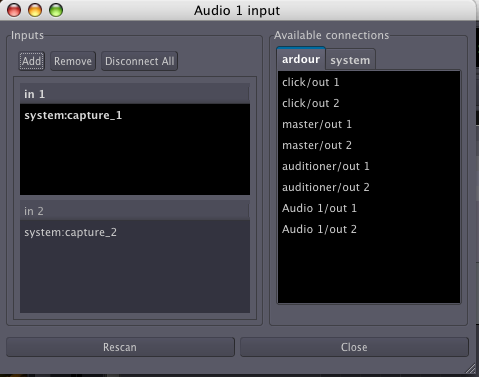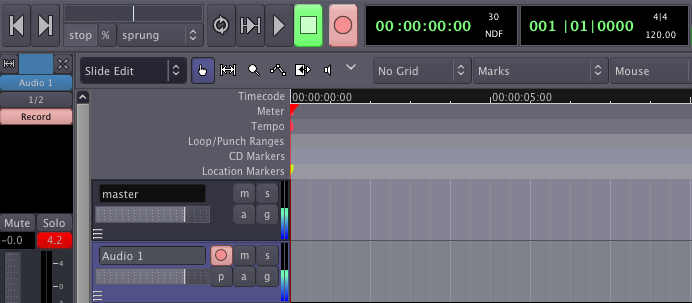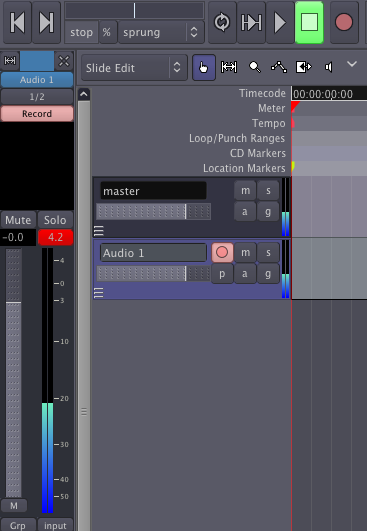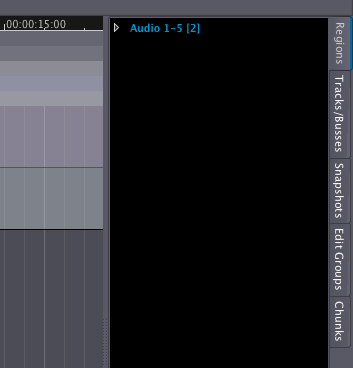Recording Audio
Besides Importing Audio, another way to create Regions in your Ardour session is to record new audio. The source of this audio could be the line or microphone inputs of your audio interface, or it could even be sound originating from other applications on your computer which have been connected to Ardour via JACK. Please see the section on Routing for more details.
This section will show you how to record audio from an external source (for example, a microphone) onto a track in Ardour.
First, you should check that the proper inputs have been routed to the track you wish to record to. Select the track by clicking on the empty space just below its name and volume slider. The Track becomes highlighted. The vertical Mixer Strip located on the left side of the Editor window should now show the Track you just selected (Audio 1 in this example). Just below the Track name in the Mixer Strip you will find a button that allows you to edit the Routing. Click on that button and select Edit to investigate the Routing.

In the image below you can see that the first and second inputs of the Track are receiving signals from system:capture_1 and system:capture_2, respectively.
On the right side, in Available connections, we see two tabs, ardour and system. The ardour tab shows the connections that can be made from other sources within Ardour. The system tab displays audio connections available from outside Ardour (for example, the built-in microphone of your computer or the inputs from your sound card). In both cases, this Routing menu communicates directly with JACK to change the Routing in the JACK system itself.

To select a source for each input, select in1 or in2 with the mouse, and then click one of the options from Available connections. Once you have selected a connection for one of the inputs, the other input will be automatically selected. Please note that with the default settings used in creating the Ardour session, the capture inputs from the sound card are automatically routed to the inputs of the Tracks. Click on Close to exit this window.

Note: the example above assumes you are recording a Stereo sound source onto a Stereo Track. If you want to record in Mono, the instructions are pretty much the same: simply remove in2 by clicking on Remove.
Arming the Track
"Arming the Track" is simply to get it ready for recording. Once you have checked that the proper capture inputs have been routed to the Track, you can arm the Track to record by clicking on the small red icon on the horizontal track strip (not the big one in the Transport controls) or the Record button on the mixer strip. When properly armed, the small red icon will remain highlighted, and you will be able to see the incoming signal by looking at the Peak Meter on the Mixer Strip or on the horizontal Track strip.
Note: unless you have told Ardour to do otherwise, the input being recorded will be monitored (in other words, heard) via the Audition output. If you are not using headphones to monitor the recording process, you may get some loud feedback at this point!
Arm Ardour and Start Recording
Now that you have armed the Track to record, you must arm Ardour itself to record by clicking on the big red button in the Transport menu. The button will blink in red, indicating that Ardour is ready to record. To start recording, click on the Play button in the Transport menu, or press the space bar of your computer keyboard. Clicking the Play button again (or pressing the space bar) will stop recording.

While recording, the armed Track will capture the sounds from the input. Any existing sound on other tracks will play normally during the recording. This allows you to play, sing or speak along with other Regions and Tracks you have already recorded or embedded in your Session.

While recording, you will be able to see the Levels (the amplitude in Decibels) of the incoming sound, as well as see the Peaks of the Waveform appearing as it is recorded.
The audio in the screenshot below was recorded too loud and produced Clipping (in other words, the signal recorded was outside the bounds of what could be represented digitally), which results in a loss of information and audible distortion. The clipped peaks in the waveform are marked in red, and the Peak Meter in the Mixer Strip has registered a maximum signal level of 10.5 Decibels over the limit of zero Decibels.

The best and easiest way to avoid Clipping is have some control over the volume of the incoming audio signal before it gets to the sound card. For example, you can can move the microphone further away from the sound being recorded or use a mixer to reduce the volume of the incoming signal.
In the following example, the audio signal has been recorded within proper limits. There are no red Peaks, and the level meter indicates a maximum of −4.7 Decibels, allowing for a comfortable distance from the Clipping Point.

The range of decibels between the region's maximum Peak and the Clipping Point is commonly referred to as Headroom. It is common recording practice to keep approximately three to six Decibels of Headroom between the maximum of your signal and the Clipping Point, with the Clipping Point itself being represented as 0dB (zero Decibels). In other words, an audio region with a comfortable amount of Headroom would have its maximum Peaks between −6dB and −3dB.
Recorded audio appears as a new Region in the recording Track. Like all Regions, this newly recorded one will be available in the Region List, from where you can drag-and-drop it into other Tracks if needed.
The Region you just recorded will automatically receive the name of the Track where it was recorded, with different takes being automatically numbered.

You might want to plan ahead and organize your recording Session by giving appropriate names to different tracks. For example, a Track used only for recording vocals can be named "Voice". This way, recorded sound files will be named accordingly, and different takes will appear in the Regions List identified as "Voice-1", "Voice-2", etc, rather than the default generic names, such as "Audio 1".
To rename a Track, just click on its name (before you arm the track to record) and type in the new name.
Continuing
At this point, you may want to skip directly ahead to the Editing Sessions section to learn how to arrange the Regions you have Recorded into a composition. If you plan on doing more complicated Recording than what we have discussed here, in particular with a multichannel soundcard, or from other JACK-enabled audio programs on your computer, you should also have a look at the Understanding Routing chapter.





